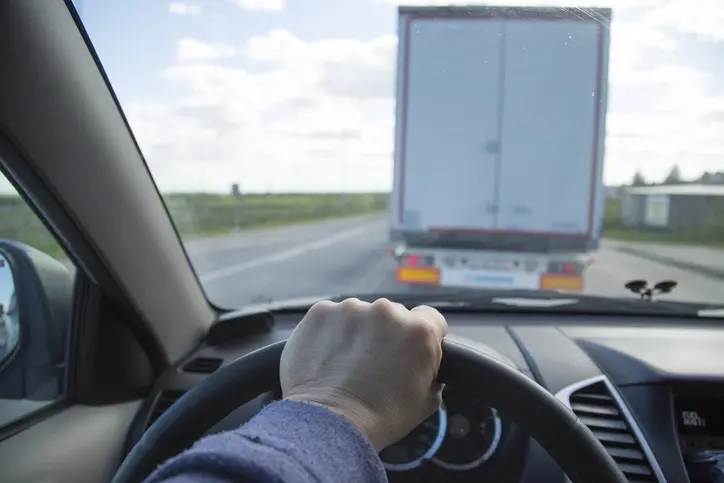Tailgating is generally illegal as most states classify tailgating as a form of aggressive driving worthy of a misdemeanor charge. There are states like California that have car accident laws preventing such forms of reckless driving from occurring on the road.
The driver of a motor vehicle shall not follow another vehicle more closely than is reasonable and prudent, having due regard for the speed of such vehicle and the traffic upon, and the condition of, the roadway.
Cal. Veh. Code § 21703
Your state’s laws may differ regarding the legality of tailgating, but most have statutes like the one above prohibit aggressive driving. If the other driver’s tailgating caused them to hit your vehicle, they may be partially at-fault for the crash.
Car crashes involving tailgating complicate how liability is calculated, especially when living in comparative negligence states. To prove your innocence while holding the at-fault driver accountable, you may need to call an auto accident attorney.
Free Auto Accident Evaluation
Hurt in a wreck that wasn’t your fault? Click here to speak with a nearby attorney for FREE about your Auto Accident claim.
or call (888)-927-3080
What is Tailgating?
The simplest definition of tailgating is the practice of driving too close to the car in front of you. The danger of tailgating is that it minimizes a vehicle’s stopping distance. That is the time it takes to come to a complete stop after a driver applies the brakes.
There isn’t one universal standard for what distance is considered “too close”. That’s because there are many variables affecting a car’s stopping ability. Some factors include vehicle size and weight, tire and road conditions, and the speed the vehicle is traveling.
In general, however, tailgating laws prohibit drivers from following a vehicle more closely than is “reasonable and prudent”. This usually includes some assessment of the existing traffic and weather conditions as well.
Why Tailgating Leads to Car Accidents
There are about 1.7 million rear-end crashes on U.S. roadways each year, or one every eight seconds.
It shouldn’t be surprising that driving too close behind another vehicle is a leading cause of rear-end collisions. Since tailgating cuts a driver’s ability to stop abruptly, there’s nowhere to go except into the front car’s back bumper.
According to the National Highway Traffic Safety Administration (NHTSA), tailgating promotes more accidents because of perception and reaction time impairments.
When a driver tailgates, there are significant reductions in both perception and reaction time. This is further reduced if another driver retaliates with brake checking or if they’re driving at night, when reaction times are weakest.
How Far Should I Drive to Avoid Tailgating?

Though there is no set “distance” for what constitutes tailgating, there are some good guidelines to help gauge what’s appropriate.
Some people say you should always stay at least two car lengths from the car in front of you. Another “car-length rule” variation is leaving one car length of space for every ten miles per hour of speed.
You might also try the seconds-counting method. The American Association of State Highway and Transportation Officials says it takes drivers approximately two seconds to react to hazards. As such, many people and law enforcement officials use the “two second rule” to determine if someone is tailgating.
Select a fixed point on the road like a tree, building, traffic light, or billboard sign. When the vehicle in front of you passes that fixed point, start counting in seconds. When you pass the fixed point, stop counting. If you are two seconds or less, you’re too close.
In most cases, even more seconds are appropriate and necessary as a minimum. The National Safety Council and many state driving manuals recommend the following:
- Three seconds for a sedan or light truck
- Four seconds for large vans or vehicles pulling trailers
- Five to six seconds for medium to large straight trucks
- Six to eight seconds for tractor-trailers
Keep in mind that the larger the vehicle, the more time it will take to stop. Also increase your distance when there is inclement weather such as rain, ice, or snow.
Is Tailgating Illegal in All States?
Because it is a dangerous practice, tailgating is generally illegal and is a traffic violation in every state in the U.S.
However, owing to the variability in how different people define “too close”, there is a subjective element to its illegality. Specific laws and penalties making tailgating illegal can vary from state to state.
For example, many states like Nevada have laws requiring drivers to leave enough space for an overtaking vehicle to safely merge. Others require vehicles with six tires to leave 300 feet of space. As such, it’s important to acquaint yourself with the tailgating rules in your location.
In most states, tailgating as a traffic infraction can result in fines, driving record points, or even license suspension.
However, when tailgating transitions into a form of road rage, it falls under the heading of reckless or negligent driving. This carries much steeper penalties and is definitely illegal nationwide.
Why Do People Tailgate?

Tailgating is sometimes the result of a driver not paying attention and drifting too close to the car preceding them. Other times, drivers may be in a hurry and they tailgate because they perceive someone to be going too slowly.
Occasionally, tailgating is an act of overt hostility. An aggressive tailgater may think they’re reprimanding the driver in front of them or telling them to move out of the way.
Whatever the motivation, tailgating is a dangerous practice that increases the odds of an accident. In fact, one study found tailgating crash risks to be higher than those for people driving while dialing cell phones.
Is Tailgating Considered Aggressive Driving?
Tailgating is a subset of road rage and as such, it falls into the category of aggressive driving.
Many aggressive drivers think that actions like tailgating put them in control on the road. However, their behavior actually puts them in more danger than if they were relaxed behind the wheel.
If someone injures or kills another individual in a car accident because they were tailgating, serious felony charges may result. This could include crimes such as assault, manslaughter, and second-degree murder.
What to Do When Someone is Tailgating You
The first thing to do if someone is illegally tailgating you is to stay calm. Even if they’re flashing their lights or making rude gestures, it doesn’t serve you to also get upset.
Other tips for managing tailgating situations so they don’t escalate or result in an accident include:
- Check your own driving. Make sure you’re not doing anything to provoke the tailgating and never brake check to retaliate against their driving habits.
- Keep watching the road. It’s easy to become distracted if someone is riding your bumper or making a scene. However, to stay safe it’s vitally important to remain aware of the things in front of you while driving.
- Allow the person to pass. The tailgater may simply be looking for an opportunity to overtake you. Give them that chance by keeping a constant speed, switching lanes, or pulling over if you must.
- Keep your distance. Maintain space between yourself and other cars on the road. Also, don’t retaliate and tailgate the tailgater once they’ve gone by you.
- Call the police. This way you can get advice for how to deal with the tailgater (and have a record if anything happens). Or, you can actually have law enforcement respond to the scene.
What to Do in a Car Accident Caused by Tailgating

Follow the same protocol you would after any other car accident. Your first step is to make sure everyone is safe. Next, check for injuries and call 911 if it seems anyone needs medical attention.
Also get the police to the scene ASAP, especially if you believe the other drivers’ tailgating was illegal. You’ll need to exchange information with the other driver. However, if tempers are high — especially if the accident emanates from road rage — it’ll help to have law enforcement present.
Be careful you don’t say anything self-incriminating or hurl blame. Any statements in the post-crash moments may come into play in future legal proceedings.
Definitely take photos of any damages, skid marks on the road, and surroundings. Also try to get contact information for any witnesses.
Since tailgating accidents are hard to prove, you’ll need all the information you can gather at the scene. Your attorney needs as much evidence as possible to prove the other driver’s tailgating directly caused your losses.
Who’s At-Fault in a Tailgating Rear-End Accident?
In most cases, the rear driver is the one most assumed to be at-fault during a rear-collision. However, there are exceptions to this, such as when the front driver causes the collision by brake checking. As a result, determining fault in tailgating cases can get tricky.
The subjectivity of what’s appropriate space between cars can mean it’s harder to prove tailgating was responsible for an accident. Many drivers may also truly believe they’re allowing a safe distance from the vehicle ahead. However, studies show most drivers don’t leave the necessary two to three-second gap.
Still, when it’s time for crash investigations, unless there’s a dashcam video, it comes down to the drivers’ statements. That’s why any proof you can collect at the scene along with witness testimonies will be essential to your claim.
Though both parties in a rear-end collision can sustain injuries, the passengers in the front car are usually hurt the most. That’s because they don’t have time to prepare for the impact of the crash.
Common rear-end collision repercussions include injuries to the face, head, spinal cord and neck (i.e. whiplash). If you are in the front car and sustained serious injuries from a tailgating accident, it may be necessary to sue the other driver for damages.
Find an Auto Attorney to See if You Qualify
If you’re wondering whether tailgating is illegal, it’s important to consult with an auto accident attorney right away. If the other driver is at-fault for a rear-end collision, they may also be liable for damages. That means they must compensate you for your injuries and property losses.
Let LegalASAP connect you with one of the skilled car accident attorneys in our network today. They can assess the facts of your case and help you file a car accident claim or court case.
Kimberly Dawn Neumann
Kimberly Dawn Neumann is a multi-published NYC-based magazine and book writer whose work has appeared in a wide variety of publications ranging from Forbes toCosmopolitan. She graduated summa cum laude from the University of Maryland, College of Journalism. For more, visit:www.KDNeumann.com, Instagram @dancerscribe, and Twitter @KimberlyNeumann


